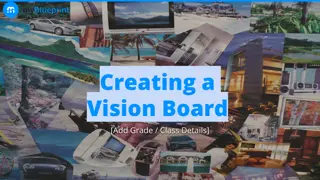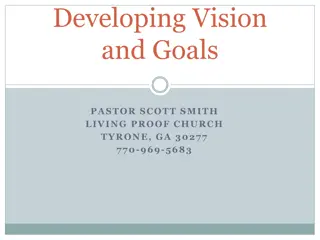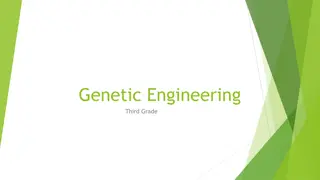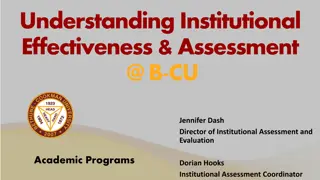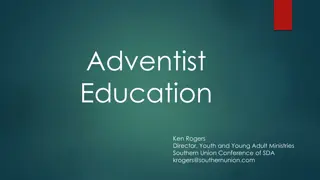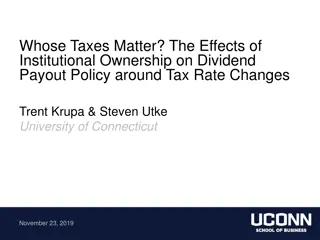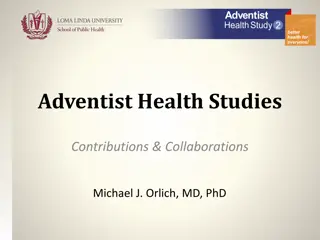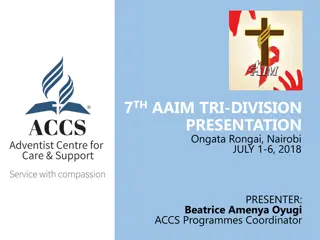Southern Adventist University Institutional Goals and Vision
Southern Adventist University's mission is to nurture a learning community that embodies Christ-likeness, truth-seeking, and service. The institution aims to provide high-quality education integrating faith and learning, graduating servant leaders committed to integrity and balanced living. Their goals focus on fostering learning communities, hiring diverse faculty, supporting students, creating a safe campus environment, promoting service opportunities, cultivating partnerships, and ensuring stewardship of resources. The academic master plan emphasizes engaging instruction, student engagement, and academic achievement.
Download Presentation

Please find below an Image/Link to download the presentation.
The content on the website is provided AS IS for your information and personal use only. It may not be sold, licensed, or shared on other websites without obtaining consent from the author. Download presentation by click this link. If you encounter any issues during the download, it is possible that the publisher has removed the file from their server.
E N D
Presentation Transcript
Student Success Factors Faculty In-Service Program Tuesday, August 25
The Mission Southern Adventist University as a learning community nurtures Christ-likeness and encourages the pursuit of truth, wholeness, and a life of service.
The Vision Southern Adventist University, responsive to its diverse constituencies, will provide high quality educational benefit, lead in the integration of faith and learning, and model academic and professional excellence. The institution will graduate servant leaders guided by faith and integrity, and committed to living balanced lives.
Institutional Goals Southern Adventist University will Learning Community nurture campus learning communities that engage students with ideas that mark educated persons, global and multicultural perspectives, and advanced technology to develop both ethical principles and intellectual flexibility. Faculty and Staff hire and develop a competent and diverse faculty and staff who model balanced ethical lives, integrate faith and learning, demonstrate scholarship through teaching, research, and other scholarly and creative activities, and celebrate and energize the student spirit as they respect and support the different ways students develop their minds, their persons, and their citizenship. Students recruit, retain, and support a capable, diverse student body. Campus Environment provide a safe, nurturing learning community of faith for students, faculty, and staff.
Institutional Goals Student Service enable every student to participate in local service and/or mission service activities. Partnerships pursue and nurture partnerships with alumni, church, community, business and industry, civic organizations, and government in order to analyze, project, and respond to changing needs to help ensure that graduates are prepared for a life of service. Stewardship steward resources entrusted to the university through effective fiscal management to fulfill its mission, vision and goals.
The Academic Master Plan 3 Themes, 9 Goals, and Actions Theme #1: Engaging Instruction: Goal #1: Support quality undergraduate academic programs through regular assessment and review. Goal #2: Enable high levels of student engagement in learning. Goal #3: Promote high academic achievement levels by students 1. Critical thinking 2. Core general education curriculum 3. Active learning 4. Service learning 5. Enrollment of qualified students
Six Conditions that Matter to Student Success (Kuh et al. 2005) Shared Responsibility for Educational Quality and Student Success Living Mission and Lived Educational Philosophy Unshakeable Focus on Student Learning Improvement- Oriented Ethos Environments Adapted for Educational Enrichment Clear Pathways to Student Success
Clear Pathways to Student Success (Support with challenge) Student success is no accident. Students who thrive in college typically engage in a variety of educationally purposeful activities and use the educational resources of the campus. To increase the odds that students will invest the time and right activities some colleges do two things very well. (Kuh 2006)
Clear Pathways to Student Success (Support with Challenge) 1. Teach students what the institution values, what successful students do, and how to take advantage of institutional resources for learning. 2. Provide redundant early warning systems, safety nets, and ongoing assessment and feedback.
What we Know About Student Feedback at Southern 1. The Noel-Levitz Student Satisfaction Inventory (SSI) Performance gaps on the question: Faculty provide timely feedback about student progress in a course. are consistently higher than other 4-year private institutions. This performance gap is statistically significant at p<.001 in most years. 2000 2002 2004 2006 2008 4-Yr Pvt 1.24 4-Yr Pvt 1.18 4-Yr Pvt 1.17 4-Yr Pvt 1.21 4-Yr Pvt 1.17 SAU SAU SAU SAU SAU 1.44 1.75 1.28 1.61 1.66
What we Know About Student Feedback at Southern National Survey of Student Engagement (NSSE) Mean response to: Received prompt written or oral feedback from faculty on your academic performance. is consistently lower than SAU s selected peer group and Carnegie Class. This performance differential is statistically significant at p<.001 in most years for first-year students and seniors. 2. 2007 Peer 2008 Peer 2009 Peer SAU CC SAU CC SAU CC FY SR 2.53 2.68 2.75*** 2.93*** 2.64 2.87** 2.44 2.61 2.79*** 2.95*** 2.75*** 2.91*** 2.54 2.80 2.75*** 2.97** 2.69*** 2.91*
References Kuh, George. D., Kinzie, Jillian., Schuh, J.H., Whitt, E.J., & Associates (2005). Student success in college: Creating conditions that matter. San Francisco: Jossey-Bass. Kuh, G., Kinzie, J., Schuh, J.H., Whitt, E.J. (2006, January 19). Student success in college: Why it matters and what institutions can do about it. First-Year Assessment Listserv. http://www.sc.edu/fye/resources/assessment/essays/Kuh-1.19.06.html


![get⚡[PDF]❤ The Healthiest People on Earth: Your Guide to Living 10 Years Longer](/thumb/20470/get-pdf-the-healthiest-people-on-earth-your-guide-to-living-10-years-longer.jpg)



